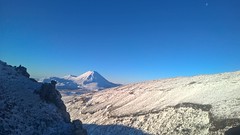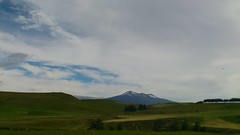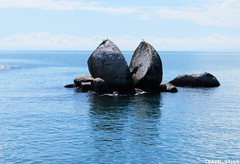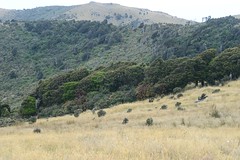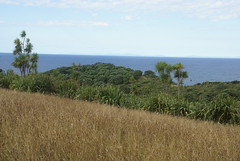 New Zealand
New Zealand
New Zealand (Māori: Aotearoa Māori: [aɔˈtɛaɾɔa]) is an island country in the southwestern Pacific Ocean. It consists of two main landmasses—the North Island and the South Island —and over 700 smaller islands. It is the sixth-largest island country by area, covering . New Zealand is about east of Australia across the Tasman Sea and south of the islands of New Caledonia, Fiji, and Tonga. The country's varied topography and sharp mountain peaks, including the Southern Alps, owe much to tectonic uplift and volcanic eruptions. New Zealand's capital city is Wellington, and its most populous city is Auckland.
The islands of New Zealand were the last large habitable land to be settled by humans. Between about 1280 and 1350, Polynesians began to settle in the islands and then developed a distinctive Māori culture. In 1642, the Dutch explorer Abel Tasman became the first European to sight and record New Zealand. In 1840, representatives of the United Kingdom and Māori chiefs signed the Treaty of Waitangi, which in its English version declared British sovereignty over the islands. In 1841, New Zealand became a colony within the British Empire. Subsequently, a series of conflicts between the colonial government and Māori tribes resulted in the alienation and confiscation of large amounts of Māori land. New Zealand became a dominion in 1907; it gained full statutory independence in 1947, retaining the monarch as head of state. Today, the majority of New Zealand's population of 5.1 million is of European descent; the indigenous Māori are the largest minority, followed by Asians and Pacific Islanders. Reflecting this, New Zealand's culture is mainly derived from Māori and early British settlers, with recent broadening of culture arising from increased immigration. The official languages are English, Māori, and New Zealand Sign Language, with the local dialect of English being dominant.
A developed country, New Zealand ranks 13th in the Human Development Index. The country was the first to introduce a minimum wage, and the first to give women the right to vote. New Zealand underwent major economic changes during the 1980s, which transformed it from a protectionist to a liberalised free-trade economy. The service sector dominates the national economy, followed by the industrial sector, and agriculture; international tourism is also a significant source of revenue. Nationally, legislative authority is vested in an elected, unicameral Parliament, while executive political power is exercised by the Cabinet, led by the prime minister, currently Chris Hipkins. Charles III is the country's king and is represented by the governor-general. In addition, New Zealand is organised into 11 regional councils and 67 territorial authorities for local government purposes. The Realm of New Zealand also includes Tokelau (a dependent territory); the Cook Islands and Niue (self-governing states in free association with New Zealand); and the Ross Dependency, which is New Zealand's territorial claim in Antarctica.
New Zealand is a member of the United Nations, Commonwealth of Nations, ANZUS, UKUSA, OECD, ASEAN Plus Six, Asia-Pacific Economic Cooperation, the Pacific Community and the Pacific Islands Forum.
Etymology
The first European visitor to New Zealand, Dutch explorer Abel Tasman, named the islands Staten Land, believing they were part of the that Jacob Le Maire had sighted off the southern end of South America. Hendrik Brouwer proved that the South American land was a small island in 1643, and Dutch cartographers subsequently renamed Tasman's discovery from Latin, after the Dutch province of Zeeland. This name was later anglicised to New Zealand.
This was written as Nu Tireni in the Māori language. In 1834 a document written in Māori and entitled "" was translated into English and became the Declaration of the Independence of New Zealand. It was prepared by , the United Tribes of New Zealand, and a copy was sent to King William IV who had already acknowledged the flag of the United Tribes of New Zealand, and who recognised the declaration in a letter from Lord Glenelg.
(pronounced Māori: [aɔˈtɛaɾɔa] in Māori and English: /ˌt.ə/ in English; often translated as 'land of the long white cloud') is the current Māori name for New Zealand. It is unknown whether Māori had a name for the whole country before the arrival of Europeans; originally referred to just the North Island. Māori had several traditional names for the two main islands, including ("the fish of ") for the North Island and ("the waters of greenstone") or ("the canoe of ") for the South Island. Early European maps labelled the islands North (North Island), Middle (South Island), and South (Stewart Island /). In 1830, mapmakers began to use "North" and "South" on their maps to distinguish the two largest islands, and by 1907, this was the accepted norm. The New Zealand Geographic Board discovered in 2009 that the names of the North Island and South Island had never been formalised, and names and alternative names were formalised in 2013. This set the names as North Island or , and South Island or . For each island, either its English or Māori name can be used, or both can be used together. Similarly the Māori and English names for the whole country are sometimes used together (Aotearoa New Zealand); however, this has no official recognition.
History
New Zealand was the last major landmass settled by humans. The story of Kupe as the first human to set foot on the New Zealand archipelago, accredited to by most Māori iwi, is considered credible by historians; he is generally believed to have existed historically. Most histories claim that in a time approximately 40 generations ago (between 900 and 1200 AD), The more specific reasons for Kupe's semi-legendary journey, and the migration of Māori in general, is contested. It is thought by some historians that Hawaiki and other Polynesian islands were experiencing considerable internal conflict at that time, which is thought to have caused an exodus from them. Some historians contest that this was because of the fallout from the 1257 Samalas eruption, which caused crop devastation globally and possibly helped trigger the Little Ice Age.
Radiocarbon dating, evidence of deforestation and mitochondrial DNA variability within Māori populations suggest that Eastern Polynesians first settled the New Zealand archipelago between 1250 and 1300, although newer archaeological and genetic research points to a date no earlier than about 1280, with at least the main settlement period between about 1320 and 1350, consistent with evidence based on genealogical traditions. This represented a culmination in a long series of voyages through the Pacific islands. It is the broad consensus of historians that the settlement of New Zealand by Eastern Polynesians was planned and deliberate. Over the centuries that followed, the Polynesian settlers developed a distinct culture now known as Māori. The population formed different (tribes) and (subtribes) which would sometimes cooperate, sometimes compete and sometimes fight against each other. At some point, a group of Māori migrated to , now known as the Chatham Islands, where they developed their distinct Moriori culture. The Moriori population was all but wiped out between 1835 and 1862 in the Moriori genocide, largely because of Taranaki Māori invasion and enslavement in the 1830s, although European diseases also contributed. In 1862, only 101 survived, and the last known full-blooded Moriori died in 1933.
In a hostile 1642 encounter between Ngāti Tūmatakōkiri and Dutch explorer Abel Tasman's crew, four of Tasman's crew members were killed, and at least one Māori was hit by canister shot. Europeans did not revisit New Zealand until 1769, when British explorer James Cook mapped almost the entire coastline. Following Cook, New Zealand was visited by numerous European and North American whaling, sealing, and trading ships. They traded European food, metal tools, weapons, and other goods for timber, Māori food, artefacts, and water. The introduction of the potato and the musket transformed Māori agriculture and warfare. Potatoes provided a reliable food surplus, which enabled longer and more sustained military campaigns. The resulting intertribal Musket Wars encompassed over 600 battles between 1801 and 1840, killing 30,000–40,000 Māori. From the early 19th century, Christian missionaries began to settle New Zealand, eventually converting most of the Māori population. The Māori population declined to around 40% of its pre-contact level during the 19th century; introduced diseases were the major factor.
The British Government appointed James Busby as British Resident to New Zealand in 1832 following a petition from northern Māori. His duties were to protect British commerce, mediate between the unruly Pākehā (European) settlers and Māori, and to apprehend escaped convicts. In 1835, following an announcement of impending French settlement by Charles de Thierry, the nebulous United Tribes of New Zealand sent a Declaration of Independence to King William IV of the United Kingdom asking for protection. Ongoing unrest, the proposed settlement of New Zealand by the New Zealand Company (which had already sent its first ship of surveyors to buy land from Māori) and the dubious legal standing of the Declaration of Independence prompted the Colonial Office to send Captain William Hobson to claim sovereignty for the United Kingdom and negotiate a treaty with the Māori. The Treaty of Waitangi was first signed in the Bay of Islands on 6 February 1840. In response to the New Zealand Company's attempts to establish an independent settlement in Wellington and French settlers purchasing land in Akaroa, Hobson declared British sovereignty over all of New Zealand on 21 May 1840, even though copies of the treaty were still circulating throughout the country for Māori to sign. With the signing of the treaty and declaration of sovereig…
Looking for places related to New Zealand?
Those are other destinations to find places related to New Zealand:




